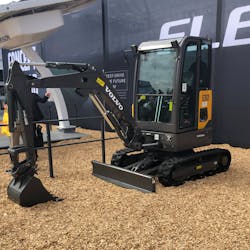The Association of Equipment Manufacturers (AEM) has released a white paper outlining the 10 key trends expected to bring dramatic change to the construction industry in North America. The Future of Building white paper outlines these trends and what is driving them, as well as how they will specifically impact the industry.
These trends are vital to monitor for those working in the fluid power and motion control industry not only due to so many companies serving the construction segment in some manner but also because many of these trends are impacting the fluid power and motion control industry as well.
AEM's Futures Council and a Vision Team comprised of thought leaders from various member companies helped guide the trends outlined which are expected to impact the industry over the next 10 years. The white paper is sponsored by Trimble and Volvo Construction Equipment, key players in the industry."With the passage of the $1.2 trillion Infrastructure Investment & Jobs Act, there is an opportunity for a generational investment to repair and rebuild our crumbling infrastructure," said AEM President Megan Tanel in the association's press release announcing the launch of the white paper. "Couple that with the ongoing shortage of skilled workers and aggressive goals to lower GHG (greenhouse gas) emissions, and it all points to the construction industry coming to a critical juncture. But utilizing the technology and innovation outlined in this whitepaper will help produce the future society we desire."
1. Increased regulation of carbon-based fuels spurs adoption of alternative power solutions
Much of the equipment utilized within the construction industry is powered by diesel engines, and thus produces harmful emissions. While regulations over the last decade have worked to curb these emissions, there is still work to do in this area.
As such, new regulations are likely to come into effect for heavy-duty off-road equipment. California is already working to curb emissions from these types of vehicles, including a ban on small gas engines starting in 2024. Heavy-duty trucks, also used on construction sites, are being charged with reducing emissions further as well. AEM's white paper cites the U.S. Environmental Protection Agency's (EPA) recently announced plans to reduce GHG from heavy-duty trucks over the next 3 years starting with model year 2027.
To meet these and other future emissions reduction targets, alternative power systems will be necessary. These include use of fuels other than diesel such as hydrogen and propane which have demonstrated low to zero emissions output.
A move to alternative fuels or other power sources such as batteries will of course have an impact on how construction machines and tools are designed, and thus the components within them.
2. Renewable energy production booms
As more alternative energy sources enter the mix, so too is the desire to produce energy in a renewable manner. Solar panels and wind turbines are among the methods being utilized.
AEM states in its white paper that the Center for Climate and Energy Solutions has reported renewable energy as the fastest-growing energy source in the U.S., rising 42% from 2010-2020. Use of renewable energy also accounts for about 12% of U.S. energy consumption according to figures from the U.S. Energy Information Administration included in the white paper.
The U.S. Department of Energy (DOE) has also set ambitious targets for solar and off-shore wind projects in the coming years. These will help to increase renewable energy production as well as offer new job opportunities, benefiting the U.S. economy.
Growth in these areas can also benefit the fluid power and motion control industries as many hydraulic, pneumatic and electronic components are used in wind turbines and other energy producing systems. Construction equipment and other tools will be necessary to build the infrastructure for these renewable energy production systems, adding yet another growth opportunity for component manufacturers.
3. Compact equipment trends electric
Already many compact construction equipment have gone electric – whether fully or on a system basis. And this trend is expected to continue in the coming years. Compact equipment has been easier to start with for electrification because of the smaller sized battery which can be utilized and the run time customers can get from the machine.
Electrification is providing many opportunities beyond emissions reduction. Noise emitted from electric machines is much lower than their diesel counterparts which benefits both workers on the job site and those who may be living or working near the construction site.
Efficiency gains are also possible when moving to electric, which can benefit machine owners' total cost of ownership. Electric power helps to provide faster, more precise operation as well as reduced wear and tear, improving productivity and costs for machine owners.The desire for increased efficiency will also drive innovation in the hydraulic circuits and components used in construction equipment notes AEM in its white paper. Pairing electronic and hydraulic technologies can offer the benefits of both solutions – the efficiency of electronics and the force of hydraulics which will still be important in heavy-duty equipment like construction machinery.
READ MORE: Electric Vehicle Development to Grow Over Next Decade
4. Connectivity leads to jobsite transformation
Construction sites, machines and the components utilized within those machines are becoming ever more connected, and this will continue growing as 5G and other technologies become more readily available. Increased connectivity allows real-time information to be provided to machine owners so they can better understand how their equipment is being used.
Connectivity through the integration of sensors and digital technologies such as the Internet of Things (IoT) are helping to provide insights into component and system health and operation as well. This can greatly benefit machine owners by enabling them to monitor system functionality and potentially minimize unplanned downtime by having better insights into when or if a component or system may fail.
With this machine connectivity, as well as connectivity among different work sites and machines, those working in the construction industry can be more productive and efficient which aids their bottom line and ability to get more work.
Component manufacturers serving the industry can benefit as well by also getting insights into how their technology solutions work in the real world. With this information they can evaluate potential new designs and uses to further benefit end-use customers.
5. Pathway toward autonomous machinery
Automation of machine systems continues to grow as a means of improving safety and productivity and as manufacturers work toward development of fully autonomous machines. By automating machine functions, there is better assurance of those functions being performed correctly and accurately.
Incorporation of sensors, software, camera systems and other technologies are enabling automation. These components often work together to provide visibility around a machine while built-in intelligence enables job site tasks to be performed with sometimes minimal effort from the operator.
There are a number of benefits to automation, one of the biggest being its ability to help overcome the skills gap facing the construction industry. Use of automated systems reduces the amount of training necessary for new machine operators as the systems are easier to use. They can also help experienced operators become more efficient and productive because the system is designed to complete job site tasks the correct way every time which assures accuracy and reduces any possible rework.
Making the machines easier to use also increases operator comfort, leading to improved safety as well.
Fully autonomous machines are likely still several years out, but their development is rising. The potential to remove operators from the machine leaves them available to work on other tasks as well as reduces the number of workers necessary which again will be beneficial given the lack of skilled labor entering this industry.
READ MORE: New Autonomous Operation Cluster Advancing Autonomy in Off-Highway Equipment
6. Sensors improve efficiency and safety
Today, sensors can be found all over a construction site from the equipment and tools utilized to wearable devices worn by workers. The data provided by sensors incorporated into machines, tools and devices offer many benefits.
Sensors can help monitor machine and human movements on a job site and work with various systems or devices to provide warnings should unsafe actions occur. Their use in wearables such as watches and helmets can monitor movement of personnel, allowing detection of falls, breaches of secure zones, exposure to heat, noise and dangerous gases as well as a worker's body temperature and heart rate says AEM in its white paper.
Use of wearable devices have helped to reduce accidents on job sites over the past decade. In the coming years, their further development is expected to provide a more holistic view of worker safety which will benefit the industry even more says AEM in its white paper.
Additional ways the association cites sensors are benefitting the industry include:
- Allowing project managers to gain visibility into material deliveries
- Noise, vibration and motion sensors helping alert managers to on-site accidents
- Computing innovations like Google Glass improving the efficiency of remote diagnostic and troubleshooting assistance
- Sensors monitoring dirt and aggregate stockpiles
7. Fewer workers, different skillsets
Like many industries, construction is facing a shortage of workers entering into the profession. AEM cites a report from McKinsey & Co. in its white paper which found close to 41% of the U.S. construction workforce is expected to retire by 2031. Older generations are retiring at high numbers, and fewer people from younger generations are filling those job openings, which will pose challenging for the construction industry.
Technology is seen as a way to potentially help overcome this. Implementation of advanced solutions like automation will not only help to do some of the work once done by those leaving the industry but also potentially attract new workers who want to use these technologies.
Younger generations are also used to having advanced technology at their fingertips and systems which are easy to use. The more these can be incorporated into the construction industry, the easier it may be to attract and train those entering the market. AEM states in its white paper that 91% of Gen Z workers – those born after the mid-1990s – say technology will influence their job choice among similar employers.
8. Business models shift toward subscriptions
The construction industry is expected to move more toward the use of subscriptions, shifting to operating expenses instead of capital expenses. As AEM explains in its white paper, the traditional model in the industry is to purchase core equipment and supplement it with rented units when necessary.
However, this requires a large investment from customers. On top of this are costs for maintaining and repairing the equipment over its lifetime.
With the growth of technology in construction equipment, it is expected machine owners will move toward an operating expenses business model to improve how they use their money. AEM says this can already be seen through the continued growth of the equipment rental market; over the last several years more companies have chosen to rent equipment instead of buying and this trend is expected to continue.
Software as a Service (SaaS) is another way companies are making this change. Instead of purchasing and maintaining software and the tools necessary to utilize it, they can pay a monthly fee to access the software.
The Equipment as a Service (EaaS) model employed in manufacturing shows potential for the construction industry as well. EaaS allows companies to lease equipment and pay based on its output and other services such as preventative maintenance. In the construction industry, AEM says in its white paper that this could allow customers to lease the most technologically advanced equipment without having to make a large investment in it. While this model is different from what the industry is used to, AEM says it could transform the industry and help bring about many advancements.
Learn more about EaaS and its benefits in the article "Equipment-as-a-Service is on the IIoT Path" from our colleagues at Machine Design.
9. Construction data will reveal its value
In tandem with the increased use of connectivity and technology integration is a rise in available data. Today there is a wide range of data which can be collected from various sources including machinery and software tools. This is enabling construction firms to better plan their work and be more proactive about safety and maintenance.
There are also a number of IoT devices and services available aimed at helping customers store and make sense of this data.
AEM says in its white paper that over the next 10 years, construction companies will be able to derive value from their data by making it available to others. Doing so will help with further evaluation of the data and best practices for improving business based on the data. Insights into weather, ground conditions, noise, vibration and more can also be done, says AEM, further helping businesses ensure safe and productive operations.
10. Cybersecurity becomes central to corporate strategy
With the growth of technology will come the need to protect the information collected, making cybersecurity an important factor for both the manufacturers developing the advanced solutions and their customers who are utilizing it.
As more machines and devices are connected on the job site, there is greater potential for cybersecurity issues. Construction companies will need to prepare themselves accordingly as they adopt more of smart, connected tools.
Given its importance to the industry, funding was included in the federal government's $1.2 trillion infrastructure bill for cybersecurity. This will make it easier for companies to afford the necessary protections for their assets.
AEM cites in its white paper findings from Trimble that spending on security increased 188% between 2018 and 2019 in construction companies, but that more will need to be done in the coming years to ensure the security of companies' data and tools.AEM concludes its white paper by saying the construction industry is at a critical juncture as it works to overcome labor shortages and meet emissions reduction targets while helping build infrastructure, homes and more.
There is great potential to be gained from technology and innovation for the industry as well as those which serve it like fluid power and motion control manufacturers. If adopted appropriately, AEM says there is the ability to produce the future society the U.S. desires.
The full white paper can be viewed and downloaded from AEM’s Future of Building page.
About the Author
Sara Jensen
Executive Editor, Power & Motion
Sara Jensen is executive editor of Power & Motion, directing expanded coverage into the modern fluid power space, as well as mechatronic and smart technologies. She has over 15 years of publishing experience. Prior to Power & Motion she spent 11 years with a trade publication for engineers of heavy-duty equipment, the last 3 of which were as the editor and brand lead. Over the course of her time in the B2B industry, Sara has gained an extensive knowledge of various heavy-duty equipment industries — including construction, agriculture, mining and on-road trucks —along with the systems and market trends which impact them such as fluid power and electronic motion control technologies.
You can follow Sara and Power & Motion via the following social media handles:
X (formerly Twitter): @TechnlgyEditor and @PowerMotionTech
LinkedIn: @SaraJensen and @Power&Motion
Facebook: @PowerMotionTech

Leaders relevant to this article:





